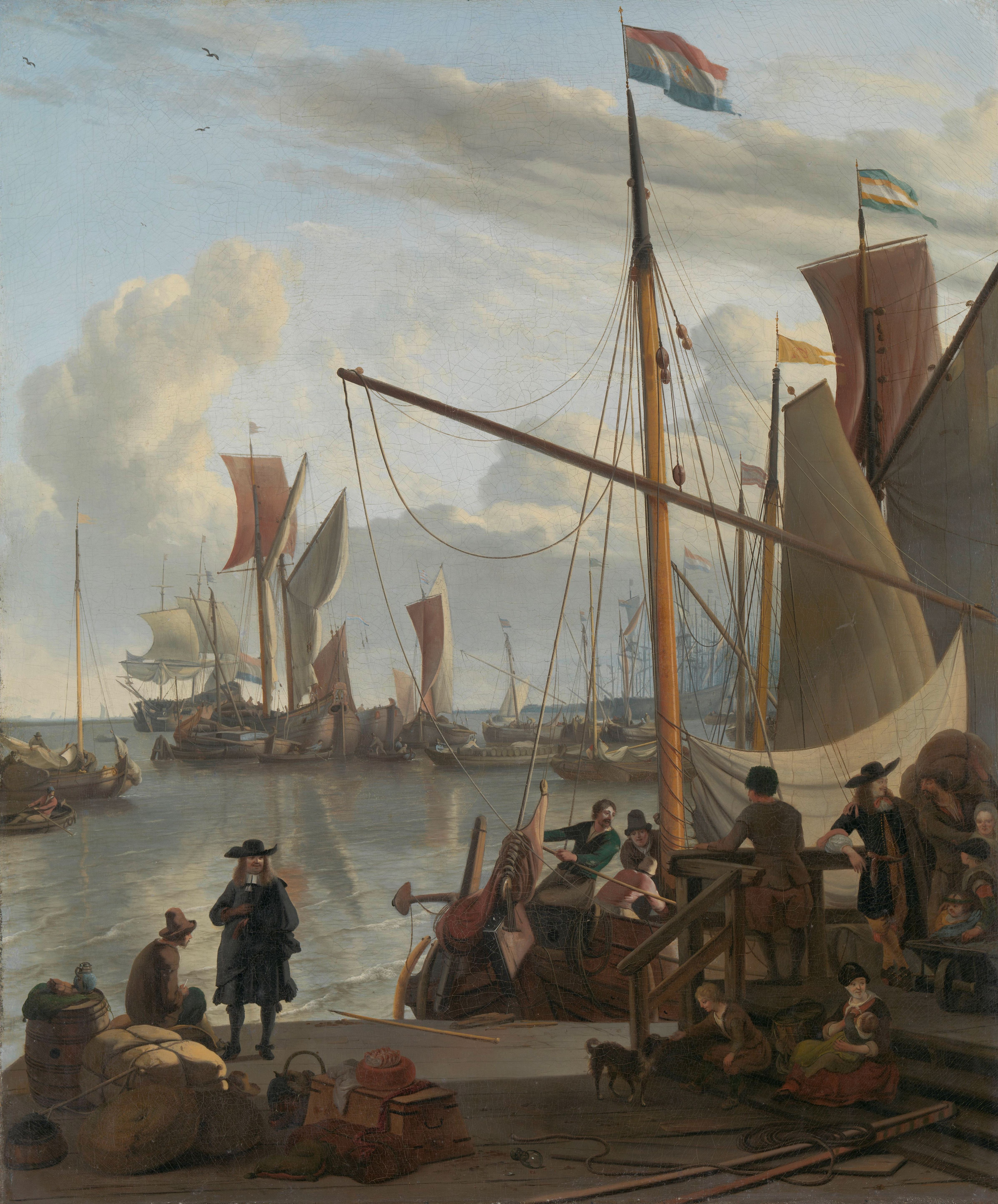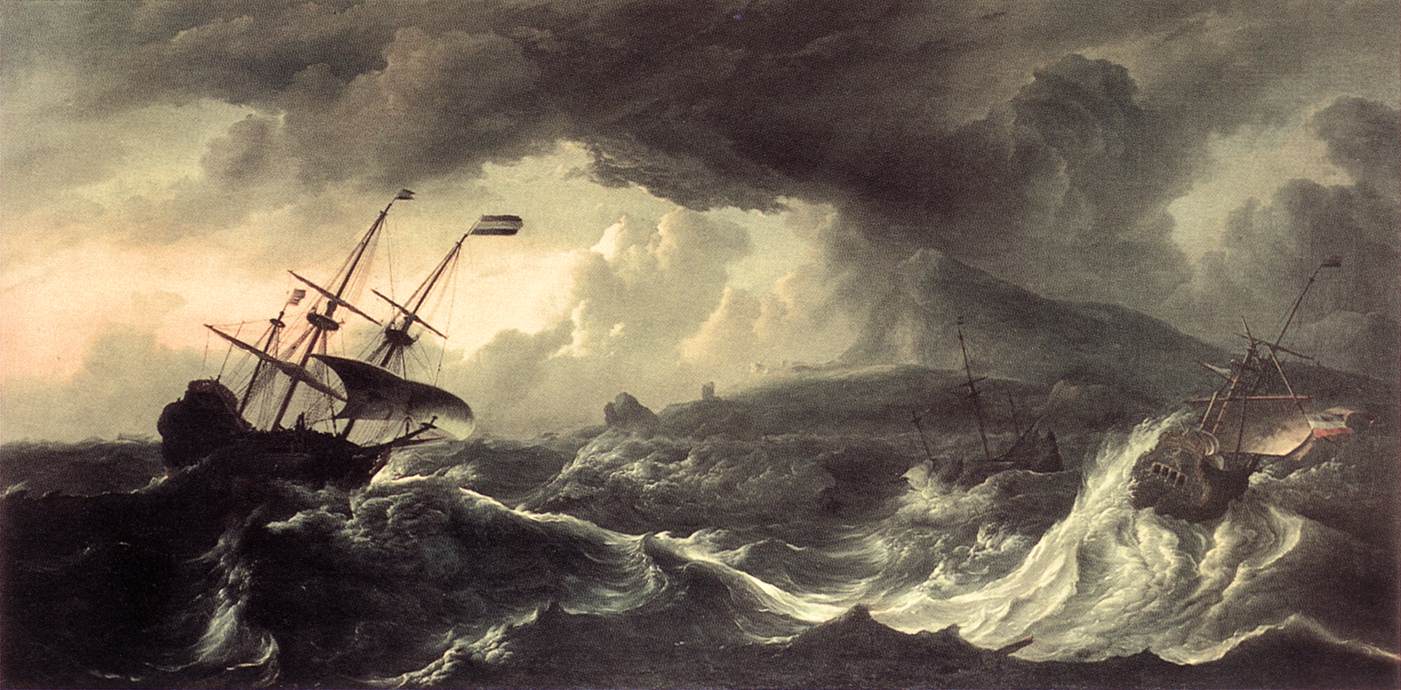Ludolf Bakhuizen (or Backhuysen) (28 December 1630 – 17 November 1708) was a German-born Dutch Golden Age painter who was the leading Dutch painter of maritime subjects after the two Willem van de Veldes (father and son) left for England in 1672.

Ludolf Bakhuizen (1631-1708)
View of Amsterdam with boats on the IJ, c. 1666
Oil on canvas
Height: 128 cm. Width: 221 cm.
Musée du Louvre
Ludolf Bakhuizen (Emden 1630-1708 Amsterdam)
A view of the IJ with the East Indiaman 'Kattendyck', a States Yacht and various other ships, the harbour of Amsterdam beyond
signed with initials, and dated '1703'
oil on canvas
88.6 x 117.5 cm.
He was born in Emden, East Frisia, and came to Amsterdam in about 1650, working as a merchant's clerk and a calligrapher. He discovered so strong a genius for painting that he relinquished the business and devoted himself to art from the late 1650s, and soon became celebrated for his sea-pieces.
Follower of Ludolf Backhuysen
Shipping on a calm sea
oil on canvas
14½ x 20¼ in. (36.8 x 51.4 cm.)
He was an ardent student of nature, and frequently exposed himself on the sea in an open boat in order to study the effects of storms. His compositions, which are numerous, are nearly all variations of one subject, the sea, and in a style peculiarly his own, marked by intense realism or faithful imitation of nature. In his later years Bakhuizen employed his skills in etching.

Ludolf Bakhuizen (1631–1708)
Dutchmen Embarking into a Yacht, c. 1670
oil on canvas
Cincinnati Art Museum
Ludolf Bakhuizen (1631–1708)
An Embarkation Scene, c. 1660
oil on canvas

Ludolf Bakhuizen (1631–1708)
The Y at Amsterdam, seen from the Mosselsteiger (mussel pier) c. 1673
Medium oil on canvas
Height: 81 cm (31.9 in). Width: 67 cm (26.4 in).
Rijksmuseum Amsterdam

Ludolf Bakhuizen (1631–1708)
The Y at Amsterdam, with the frigate ‘De Ploeg’, circa 1690
oil on canvas
68 × 81 cm (26.8 × 31.9 in)
Rijksmuseum Amsterdam
View of a port with many larger and smaller ships including the tall ship ‘De Ploeg’ (The Plough, a frigate with a ploughing farmer painted on her stern). The city can be identified as Amsterdam though its buildings (from left to right: Oude Kerk, Royal Palace, Haringpakkerstoren and Westertoren). In the foreground various people, on the right a jetty. More
Ludolf Bakhuizen (1631–1708)
The Foundering of the 'Coronation' 90 Guns at Rame Head, c. 1691
Oil on canvas
147.3 x 231.1 cm
Sir Max Aitken Museum
Coronation was commissioned on 14 February 1690 under Captain John Munden, as flagship of Vice-Admiral Sir Ralph Delavall, under whom she took part in the Battle of Beachy Head on 30 June 1690. On 29 October 1690 Captain Charles Skelton took command. Coronation was dismasted and wrecked in a storm off Rame Head on 3 September 1691; approximately 600 men drowned, including Skelton. Only 20 survived. More

Ludolf Bakhuizen (1631–1708)
Ships Running Aground in a Storm, c. 1690s
Medium oil on canvas
59 x 89 1/4 inches
Royal Museums of Fine Arts of Belgium
While Dutch primacy in merchant shipping offered high rewards, its risks were equally significant. On their long journeys to the Mediterranean, the New World, Africa, and the East, merchant vessels were perennially endangered by warfare, piracy, treacherous shores, and storms. Several painters, most dramatically Ludolf Backhuysen, specialized in ships adrift in tempests. Backhuysen executed this painting (his largest surviving one) as if he were observing the disaster in the midst of the roiling seas, thus engaging beholders in the unfolding tragedy, encouraging them to empathize with the ships and their crews and to contemplate the powers of God, beyond full comprehension. But even as such paintings acknowledge the fragility of Dutch seaborne success, their distant shafts of sunlight usually hold out hope for reversals of misfortune. A brighter future may still save Backhuysen's ship at left, its Dutch flag unfurled against lightening skies. Collectors occasionally hung a tempest painting opposite a sunny shipping scene, implying that the power of God and nature, whether terrifying or benevolent, is always magnificent. More

Ludolf Bakhuizen (1631–1708)
Ships in Distress in a Heavy Storm, circa 1695
oil on canvas
150 × 227 cm (59.1 × 89.4 in)
Rijksmuseum Amsterdam
The man-of-war ‘Ridderschap’ (right) and ‘Hollandia’ (left) on the rocks during a storm in the Strait of Gibraltar
Ludolf Bakhuizen (Emden 1630-1708 Amsterdam)
Ships in Distress off a Rocky Coast (1667)
oil on canvas
The large cargo ship in the centre is managing to make way along the perilous coast, while on the right, two vessels are in even greater danger. Later his storms become melodramatic, his chiaroscuro effects exaggerated, and his gigantic waves rather schematic and glass-like.

Ludolf Bakhuizen (1631–1708)
A Storm in the Sea, c. 1702
Medium oil on canvas
97.8 × 128.5 cm (38.5 × 50.6 in)
Royal Castle in Warsaw
This painting depicts two British and one Dutch ship during the War of the Spanish Succession.

Backhuysen, Ludolf (1631-1708)
Boats in a Storm, 1696
oil on canvas
24 3/4 x 31 inches (63 x 79 cm)
The Bridgeman Art Library

Ludolf Bakhuizen (1631–1708)
Fishing Boats and Coasting Vessel in Rough Weather, between 1660 and 1663
oil on canvas
Height: 46 cm (18.1 in). Width: 66 cm (26 in).
Louvre Museum

Ludolf Backhuysen (1630-1708)
The warship Brielle on the Maas before Rotterdam, c. 1689
Oil on canvas
Height: 130 cm (51.2 in). Width: 197 cm (77.6 in).
Rijksmuseum Amsterdam
In the center of this painting is the Brielle, a 50-gun warship sailing by the Admiralty Buildings in Rotterdam. Her stern is decorated with a shield bearing the portrait of William III, Prince of Orange, with arms of England and Scotland on either side. The main mast is flying the flag of the Prince and a splitted pennant. To the right is a VOC yacht (possibly with Princess Mary, the Prince’s wife, on board) firing a salute. Two boats are accompanying the yacht, one of them is under the flag of the States-General. In the background one can see Rotterdam: the western and the eastern New Main Gate to the Leuvehaven, the St. Lawrence Church, City Hall and the old warehouse of the Admiralty. More

Ludolf Bakhuizen (1631–1708)
The Eendracht and Dutch fleet of men-of-war before the wind’-ca 1670
Medium oil on canvas
London-National Gallery
The depiction of the Eendracht’s ornate stern here is not accurate. In reality the lion was carved rampant and set within a fence symbolizing the borders of the Dutch Republic that he protected. This inaccuracy suggests that the painting was created after the loss of the Eendracht, probably in the early 1670s. This painting is on display in the National Gallery in London. More

Ludolf Bakhuizen (1631–1708)
The Battle of Barfleur, 19 May 1692
oil on canvas
158.5 × 234.5 cm (62.4 × 92.3 in)
National Maritime Museum
Early in 1692, James II was at Cherbourg, preparing to re-invade England with French help. On 17 May the French fleet sailed from Brest and were attacked by a superior Anglo-Dutch force under Admiral Russell, off Cape Barfleur. The French escaped but a few days later the allies burnt three of their ships including their flagship the 'Soleil Royal', 104 guns, in Cherbourg Bay. On 23-24 May, James II saw 12 more French ships and most of his transports burnt in the Bay of La Hogue. This ended all real hope of regaining his throne. The French commander off Barfleur was the Comte de Tourville. With a force half the size of the Anglo-Dutch fleet and hampered by fog, put up a brave fight. The focal point in the painting is de Tourville's flagship 'Soleil Royal', shown in the middle distance to the left of centre and in starboard-quarter view, in close action with the allied fleet flagship 'Britannia', on her starboard side. She is running before the wind, as are the fleets in general. This interpretation ignores the presence of fog and falsely indicates that the visibility is good. Astern of the 'Soleil Royal', firing her chase guns, is the flagship of Vice-Admiral-General van Callenburgh, and close on her port side a Dutch ship is also in chase. Beyond them and behind are other Dutch ships with, in the middle, an English smack-rigged royal yacht beating across them on the starboard tack. In the left foreground is a sinking French ship and to the right a number of boats and barges. A burnt-out wreck smoulders on the extreme right foreground. More
Ludolf Bakhuizen (Emden 1630-1708 Amsterdam)
The merchant shipping anchorage southeast of Texel by Ludolph Backhuysen, 1661
oil on canvas
28*23 cm.
This painting shows the merchant anchorage off the island of Texel, where ships of the Dutch East Indian Company used to gather before setting sail for East Indies. In the center there are three vessels, a boyer, a kaag and a pink, full of people loading cargo. The smaller boats are delivering supplies to the larger boyer, while its crew is busy hoisting sails.
The scene is full of dynamism in the style that distinguishes Backhuysen from his contemporaries. The light-colored sail directs viewer’s attention to the events on board of the pink where a family of one of the departing mariners is captured in the height of excitement. More

Ludolf Bakhuizen (1631–1708)
The Merchant Shipping Anchorage off Texel Island with Oudeschild in the Distance, c. 1665
oil on canvas
1065 mm x 1650 mm
National Maritime Museum, London
The painting, executed in 1665, was produced at the height of Backhuysen’s career. More

Ludolf Bakhuizen (1631–1708)
The Battle of Vigo Bay, 12 October 1702
Medium oil on canvas
483 × 686 mm (19.02 × 27.01 in)
National Maritime Museum
Rooke had been sent with a large Anglo-Dutch force to capture Cádiz in Spain but retreated in defeat on 29 September 1702. When the returning fleet put in to water at Lagos, Portugal, Rooke learned that the 1702 Spanish treasure fleet, one of the richest ever assembled, had sailed on 24 July from Havana, Cuba, and had been diverted from Cadiz to Vigo, where it had arrived on 23 September.
Determined to salvage something from the disaster at Cádiz, Rooke set out for Vigo, where he found that the treasure fleet was protected by a Franco-Spanish fleet of about 30 ships. Chateau-Renault had fortified the harbour by laying a boom of masts, covered by guns from forts in the town and on the island of San Simón, near the town of Redondela.
On October 23 Rooke attacked.The battle was a complete victory for Rooke: the forts were captured, and all the Spanish and French ships were burned by their own side. The victors recovered silver to the value of about £14,000, but a far larger sum — perhaps three million pounds — had been unloaded and taken away before the battle. Jan Lettens 23/10/2010

Ludolf Backhuysen - EMDEN 1630 - 1708 AMSTERDAM
A MAN-O-WAR, TOGETHER WITH BOATS AND FISHERMEN HAULING IN THEIR CATCH
signed lower right: Lud. Backh
a penschilderij, pen, ink and oil on oak panel
32.5 by 41.2 cm.; 11 7/8 by 16 1/4 in.
Ludolf Backhuysen - EMDEN 1630 - 1708 AMSTERDAM
The Shipyard of the Amsterdam Admiralty
Pen on panel
38 cm × w 69 cm




No comments:
Post a Comment